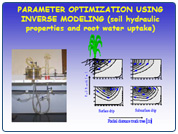 |
Download: Presentation |
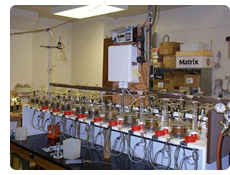 Characterization of soils and the vadose zone includes the estimation
of the soil water retention and unsaturated hydraulic conductivity relations
over a wide range of volumetric water content values. Although occasionally
only specific data points are needed, parametric models for both hydraulic
properties are preferred. The demand for these expressions is driven by
their use in numerical models for simulating fluid flow and mass transport.
The increasing availability of simulation models, their increasing ease
of use, and their ability to accurately predict flow and transport, has
created a need for parametric expressions which describe hydraulic relations
for both near-surface soils and deep vadose zones. Typically, the soils
to be characterized exhibit large variations in space and occasionally
in time as well. Consequently, relatively efficient techniques are needed
that can measure these variations.
Characterization of soils and the vadose zone includes the estimation
of the soil water retention and unsaturated hydraulic conductivity relations
over a wide range of volumetric water content values. Although occasionally
only specific data points are needed, parametric models for both hydraulic
properties are preferred. The demand for these expressions is driven by
their use in numerical models for simulating fluid flow and mass transport.
The increasing availability of simulation models, their increasing ease
of use, and their ability to accurately predict flow and transport, has
created a need for parametric expressions which describe hydraulic relations
for both near-surface soils and deep vadose zones. Typically, the soils
to be characterized exhibit large variations in space and occasionally
in time as well. Consequently, relatively efficient techniques are needed
that can measure these variations.
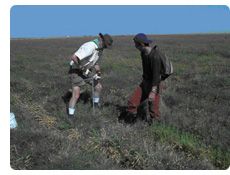
Alternatively, indirect estimation techniques are becoming increasingly popular, so that parameters of soil hydraulic functions can be estimated from other, easier to measure soil physical properties such as particle size distributions and soil structural characteristics. Alternatively, functional descriptors of water flow and transport can be derived from the parameters of soil hydraulic functions, such as in the use of pedotransfer functions to define land or soil quality indicators.
A. Measurement of soil hydraulic properties using
the multi-step outflow technique
B. Neural network prediction
____________________________________________________________
A. Multi-step outflow technique
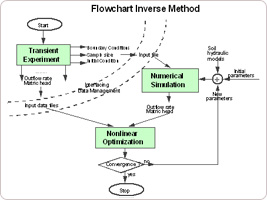
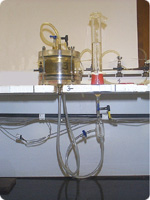
In the past 10 years or so, our laboratory with various graduate students and collaborators has developed the so-called multi-step outflow method, to estimate the soil hydraulic functions, i.e. the soil water retention and unsaturated hydraulic conductivity functions. After demonstrating the successful application of the inverse modeling approach to estimate laboratory-measured soil hydraulic functions, we have suggested to use this technique to estimate the capillary pressure and permeability functions for multi-fluid systems such as for soils that include oil, air and water. Although scientists were initially reluctant to accept this indirect measurement approach, an increasing number of laboratories worldwide are acknowledging the benefits of this technique, and are adapting our techniques. For that purpose we have written special reports, which in detail describe the required experimentation, procedures and simulation/optimizations models. My laboratory has currently the instrumentation for almost complete automation of the required measurements, allowing hydraulic characterization of 10-15 soil samples simultaneously within a 2-week period.
References:
Kosugi, K., J.W. Hopmans and J.H. Dane. 2002. Water Retention and Storage
- Parametric Models. IN: Methods of Soil Analysis. Part 4. Physical Methods.
(J.H. Dane and G.C. Topp, Eds.). Soil Science Society of America Book
Series No. 5. Pages 739-758.
DOWNLOAD:
PDF
Hopmans, J.W., J. Simunek, N. Romano, and W. Durner. 2002. Simultaneous determination of water transmission and retention properties. Inverse Methods. IN: Methods of Soil Analysis. Part 4. Physical Methods. (J.H. Dane and G.C. Topp, Eds.). Soil Science Society of America Book Series No. 5. Pages 963-1008. DOWNLOAD: PDF
Dane, J.H., and J.W. Hopmans. 2002. Soil Water Retention and Storage - Introduction. IN: Methods of Soil Analysis. Part 4. Physical Methods. (J.H. Dane and G.C. Topp, Eds.). Soil Science Society of America Book Series No. 5. Pages 671-674. DOWNLOAD: PDF
Wildenschild, D., J.W. Hopmans and J. Simunek. 2001. Flow Rate Dependence of Soil Hydraulic Characteristics. Soil Sci. Soc. Amer. J. 65:35-48. DOWNLOAD: PDF
Wendroth, O., W. Ehlers, J.W. Hopmans, H. Kage, J. Halbertsma, and J.N.M. Wosten. 1993. Re-evaluation of the evaporation method for determination of hydraulic functions in unsaturated soil. Soil Sci. Soc. Amer. J. 57:1436-1443. DOWNLOAD: PDF
Eching, S.O., J.W. Hopmans, and O. Wendroth. 1994. Unsaturated hydraulic conductivity from transient multistep outflow and soil water pressure data. Soil Sci. Soc. Amer. J. 157(3):687-695. DOWNLOAD: PDF
S.O. Eching, and J.W. Hopmans. 1993. Optimization of hydraulic function from transient outflow and soil water pressure data. Soil Sci. Soc. Amer. J. 57:1167-1175. DOWNLOAD: PDF
Tuli, A., M.A. Denton, J.W. Hopmans, T. Harter and J.L. MacIntyre. 2001. Multi-step outflow experiments: from soil preparation to parameter estimation. LAWR Report No. 100037. 109 pages. DOWNLOAD: PDF
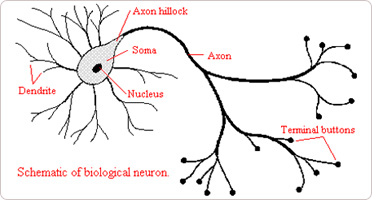
In the past decade, artificial neural networks have become an alternative method for the prediction of soil properties. A neural network is modeled after the functioning of the nervous system. Through a complex mathematical structure of interconnecting layers, knowledge is acquired through a learning process by which interneuron connection strengths (weights) are used to store knowledge. Early applications of artificial neural networks in hydrology included neural kriging, optimization of groundwater remediation by extraction wells, and rainfall-runoff time series forecasting.
Indirect methods for prediction of soil hydraulic properties play an important role in understanding site-specific unsaturated water flow and transport processes, usually via numerical simulation models. Specifically, pedotransfer functions to predict soil water retention have been widely developed. However, few datasets that include unsaturated hydraulic conductivity data are available for prediction purposes. Moreover, those available employ a variety of measurement techniques. We show that prediction of soil water retention and unsaturated hydraulic conductivity data from basic soil properties can be improved if hydraulic data are determined using a single measurement method that is consistently applied to all soil samples. Here, we present a unique dataset that consists of 310 soil water retention and unsaturated hydraulic conductivity functions, all of which were obtained from the multi-step outflow method. With this dataset a neural network with bootstrap aggregation was trained to predict the soil water retention and hydraulic conductivity characteristics from basic soil properties, i.e., sand, silt, and clay content, bulk density, saturated water content, and saturated hydraulic conductivity. The prediction errors of water content were about 3 to 4 volume percent. Results from a sensitivity analysis suggest that the hydraulic parameters are mostly sensitive to sand content and saturated water content.
References:
Minasny, B., J.W. Hopmans, T.H. Harter. A.M. Tuli. S.O. Eching and D.A. Denton. 2004. 2004. Neural network prediction of soil hydraulic functions for alluvial soils using multi-step outflow data. Soil Science Soc. Amer. J. 68:417-429. DOWNLOAD: PDF
Websites:
University of Sydney, Australia: Link
US Salinity Laboratory, Riverside, CA, USA: Link